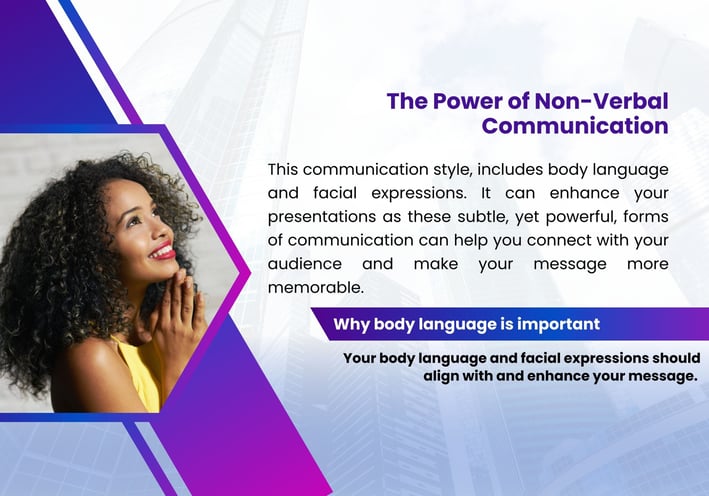Non-Verbal Communication: Facial Expressions, Gestures, and Eye Contact
Discover how non-verbal cues like facial expressions, gestures, and eye contact can enhance your public speaking skills. Learn the importance of non-verbal communication in conveying a powerful mes...
The Critical Role of Non-Verbal Communication in Public Speaking
Introduction:
In the practice of public speaking, the words you use are crucial, but the way you deliver them through non-verbal cues can be just as powerful, if not more so. Non-verbal communication includes all the ways a speaker can convey a message without spoken words, such as facial expressions, gestures, posture, and eye contact. These elements play a critical role in enhancing the effectiveness of your speech, influencing how the audience perceives and reacts to your message. Mastering non-verbal communication not only supports your verbal interactions but also strengthens your overall presentation, helping to engage the audience and convey your points with greater impact. This blog post will delve into the various aspects of non-verbal communication in public speaking, providing insights and practical tips to harness this powerful tool effectively.
Understanding Non-Verbal Communication in Public Speaking
What Is Non-Verbal Communication?
Non-verbal communication in public speaking refers to the ways a speaker can communicate without using words. This includes facial expressions, gestures, body movements, posture, and eye contact. Each of these components can significantly enhance or undermine the spoken message, serving to clarify, contradict, complement, accent, or repeat what is being said. Effective non-verbal communication helps to build rapport with the audience, convey emotions, and provide emphasis to key points, making the speech more engaging and memorable.
The Science Behind Non-Verbal Communication
Psychologically, non-verbal cues have a profound impact on how messages are perceived. According to studies in communication, non-verbal elements can carry more than half of the communicative value in a conversation. This is because the human brain responds instinctively to visual cues, often processing them faster than the content of speech. Non-verbal cues can trigger emotional responses or lead to judgments about the speaker's credibility, confidence, and empathy, thereby influencing the audience’s engagement and reaction.
Comparing Verbal and Non-Verbal Communication
While verbal communication transmits information via words, non-verbal communication does so through physical behaviors. This interaction between verbal and non-verbal forms is crucial for public speakers to understand:
Reinforcement: Non-verbal cues can reinforce the spoken words, adding strength to the verbal message.
Contradiction: When non-verbal signals contradict the words spoken, they can cause confusion and lead to mistrust.
Substitution: Sometimes, non-verbal cues can substitute for verbal language, such as nodding instead of saying "yes."
Accentuation: Enhancing the importance of a verbal message through physical gestures, like pounding a fist to emphasize a point.
Understanding the dynamics and effects of non-verbal communication can significantly enhance a speaker's ability to deliver powerful and persuasive presentations.
Types of Non-Verbal Communication Used in Public Speaking
Facial Expressions as Emotional Signals
Facial expressions are among the most powerful forms of non-verbal communication. A speaker's face can express a range of emotions, from joy and surprise to anger and confusion, often without a single word being spoken. These expressions can convey sincerity and enthusiasm, helping the audience to connect emotionally with the content being presented. For instance, a genuine smile can make a speaker appear more approachable and trustworthy, while a frown or look of confusion might signal disagreement or concern, prompting the audience to pay closer attention.
The Significance of Gestures
Gestures, whether deliberate or unconscious, play a critical role in communication. They can be classified into several types, including:
Descriptive Gestures: These are used to describe or mimic the action being spoken about, such as showing the height of an object with a hand.
Emphatic Gestures: These are used to emphasize a point, like pounding a fist into a palm to underline significance.
Suggestive Gestures: Subtle gestures that suggest a particular state or condition, such as shrugging shoulders to indicate uncertainty.
Effective use of gestures can greatly enhance the clarity and impact of a speech, making abstract ideas more concrete and memorable.
Posture and Movement
A speaker's posture and movement convey a wealth of information about their confidence, openness, and status. Standing upright with an open stance can suggest confidence and readiness to engage, whereas crossed arms or legs might be perceived as defensive or less approachable. Controlled movement around the stage can help to hold the audience’s attention and facilitate a connection with different parts of the audience.
The Power of Eye Contact
Eye contact is essential in establishing a connection with the audience. It can convey honesty, confidence, and respect for the listeners, fostering a sense of engagement and mutual respect. Maintaining good eye contact shows that you are focused on the audience and committed to your message. It can also provide feedback, as speakers can gauge audience reactions and adjust their delivery accordingly.
By mastering these non-verbal cues, speakers can add depth and emotion to their presentations, making their messages more compelling and impactful.
Enhancing Your Non-Verbal Skills
Exercises for Improving Facial Expressiveness
Facial expressions can significantly impact how messages are received and interpreted by an audience. To enhance facial expressiveness:
Mirror Exercises: Practice speaking in front of a mirror, consciously altering your facial expressions to match the tone of your message. This helps you become aware of how you naturally express emotions and where you might need improvement.
Emotion Replication: Watch videos of expressive speakers and attempt to mimic their facial expressions. This can improve your ability to convey specific emotions intentionally during your speeches.
Techniques for Effective Gesture Use
Gestures can help clarify and enhance your verbal messages, making them more memorable and engaging. To use gestures more effectively:
Gesture Mapping: Plan out key gestures during your speech preparation. Identify the parts of your speech that could benefit from gestures for emphasis or illustration.
Spontaneous Gesturing: Allow some gestures to arise naturally as you speak. This can make your delivery seem more genuine and less rehearsed. Practice speaking on various topics in a relaxed setting to encourage natural gesturing.
Training for Better Posture and Movement
Good posture and purposeful movement convey confidence and command attention. To improve in this area:
Posture Awareness: Regularly check and correct your posture throughout the day, not just when you are speaking publicly. Practice standing and sitting with your back straight and shoulders back.
Movement Practice: Use the entire stage area during rehearsals to get comfortable with moving while speaking. Plan movements that feel natural and purposeful, avoiding pacing or random wandering.
Developing Strong Eye Contact Skills
Effective eye contact keeps your audience engaged and makes your communication more personal. To develop strong eye contact skills:
Eye Contact Drills: Practice speaking to a group of friends or colleagues and make a point to look each person in the eyes briefly. This helps build comfort with maintaining eye contact with multiple people in a larger setting.
Use of Markers: During rehearsal, place markers at various points around your practice room to simulate different audience members. Practice making eye contact with these markers as you speak.
Enhancing these non-verbal skills through deliberate practice can dramatically improve how your message is received and can help to forge a stronger connection with your audience, ensuring your communication is as effective as possible.
The Impact of Non-Verbal Communication on Audience Engagement
Case Studies of Successful Public Speakers
Examining the techniques of renowned public speakers provides valuable insights into effective non-verbal communication. Speakers like Steve Jobs and Oprah Winfrey have mastered the art of engaging audiences partly through expert use of non-verbal cues. Jobs, for example, was known for his minimalist gestures and controlled use of space, which helped to command attention and underscore his messages. Oprah often uses open gestures and direct eye contact, which foster a sense of intimacy and trust with her audience.
Research Insights on Audience Reactions
Research has consistently demonstrated the profound impact of non-verbal cues on audience engagement. Studies highlight that audiences are more likely to retain and react positively to speeches where speakers effectively use gestures, facial expressions, and eye contact. For instance, a study published in the Journal of Nonverbal Behavior found that speakers who made greater eye contact with their audience were perceived as more persuasive and trustworthy than those who did not.
Facial Expressions: Convey emotional undertones that can make the spoken content more relatable and memorable.
Gestures: Help emphasize and clarify points, making complex information more accessible.
Posture and Movement: Influence perceptions of the speaker’s confidence and authority, which can affect the audience's confidence in the message being delivered.
Eye Contact: Builds a personal connection, making each member of the audience feel acknowledged and involved.
This section could further include interactive elements like pie charts or bar graphs illustrating statistics on how non-verbal cues affect audience retention rates or engagement levels during public speeches.
By understanding and utilizing the impact of non-verbal communication, speakers can significantly enhance audience engagement, making their speeches not only more compelling but also more effective in achieving their communication goals.
Overcoming Challenges with Non-Verbal Communication
Common Non-Verbal Communication Mistakes
Even experienced speakers can fall prey to common non-verbal communication mistakes that may detract from their message. Here are some frequent issues to be aware of:
Overuse of Gestures: While gestures can enhance speech, excessive use can be distracting. It's crucial to find a balance where gestures complement rather than overpower the message.
Inconsistent Signals: Sending mixed signals, such as smiling while discussing a serious issue, can confuse the audience and weaken your credibility.
Lack of Awareness: Unintentional body language, like crossing arms or fidgeting, can convey nervousness or defensiveness, undermining the intended message.
Adapting Non-Verbal Cues for Different Cultural Contexts
Non-verbal communication can vary significantly across cultures, and what is acceptable in one culture might be inappropriate in another. Here are tips for adapting your non-verbal cues:
Research Cultural Norms: Before speaking to an international audience, research the local customs and norms related to non-verbal communication. For example, the amount of eye contact considered appropriate can vary widely.
Seek Local Advice: When possible, consult with locals or cultural experts to understand the nuances of non-verbal communication in a particular setting.
Observe and Adapt: During your speech, be observant of the audience's reactions to your non-verbal cues and be prepared to adjust your behavior accordingly to maintain a connection.
Overcoming these challenges requires a conscious effort to understand and control your non-verbal cues. By developing this awareness, speakers can ensure that their non-verbal communication strengthens rather than undermines their messages.
Tools and Resources for Mastering Non-Verbal Communication
Recommended Books and Courses
Improving your non-verbal communication skills can be greatly facilitated by accessing the right educational resources. Here are some highly recommended books and online courses:
Books:
“What Every BODY is Saying” by Joe Navarro. This book, written by an ex-FBI agent, provides insights into how to read and use body language in all facets of life, including public speaking.
“The Definitive Book of Body Language” by Allan and Barbara Pease. This comprehensive guide explores the hidden meanings behind various non-verbal cues and how they can be harnessed to improve communication.
Online Courses:
“Body Language for Speakers” available on platforms like Udemy or ClassCentral. These courses teach how to use body language effectively to engage and influence an audience.
“Reading Body Language” by Todd Dewett on LinkedIn Learning, which focuses specifically on improving non-verbal skills for public speakers.
Helpful Apps and Technology
Leveraging technology can also enhance your ability to understand and improve your non-verbal communication:
Proximity: This app provides real-time feedback on your body language by analyzing video recordings of your speeches, helping you identify and correct non-verbal cues.
Virtual Reality Training: VR platforms like VirtualSpeech offer scenarios that simulate public speaking environments where you can practice your non-verbal communication skills and receive feedback.
Maintaining Vocal Health for Public Speakers
Keeping your voice healthy is an essential part of non-verbal communication, especially for public speakers who rely heavily on their vocal cords:
Hydration: Keeping hydrated helps maintain vocal cord lubrication, which is crucial for clear speaking.
Vocal Rest: Ensure you give your voice enough rest between speaking engagements to prevent strain.
Warm-Ups: Regular vocal warm-ups can help prepare your voice for speaking, reducing the risk of damage.
By utilizing these tools and resources, speakers can refine their non-verbal communication skills, enhancing their overall effectiveness and ensuring their messages are delivered as powerfully as possible.




© 2024 The Confident Orator. All rights reserved.


